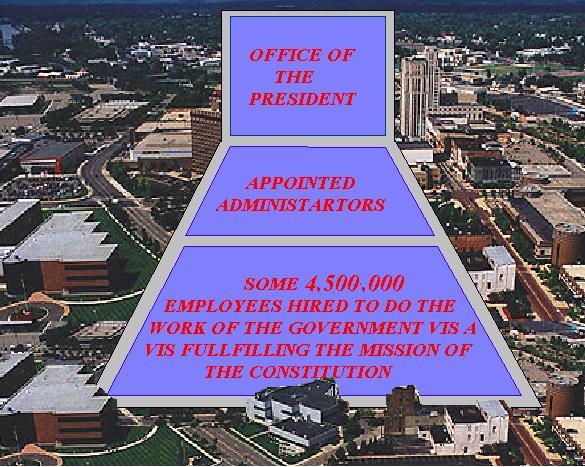
ARTICLE II - PRESIDENT
Review of Congress:
POLICY PROCESS-
Legislative Branch: Builds (formally identifies problems), Formulates (brainstorms solutions for the problem), Adopts (chooses a solution).
Executive Branch: Implements (carries out the solution adopted).
Judicial Branch: Evaluates (applies the rules found in the Constitution and its interpretations to see if what was implemented doesn't break these rules).
POWER- IS, the ability to cause change, or withstand it.
INITIATIVE- IS, taking it upon your self to formulate legislation.
REFERENDUM- IS, putting proposed legislation before the public to accept or reject.
AMENDMENT- IS, a "fine tuning" of a bill.
SUBSTITUTION- IS, a "major overhaul" of a bill.
FILIBUSTER- IS, "Talking a bill to death." The traditional mode of delay used only in the US Senate, usually by the minority party.
CLOTURE-IS, The way to kill a filibuster. Takes a 60 Senator vote to pass.
HOW A BILL BECOMES A LAW- [WRITTEN] -and- [DIAGRAM]
Presidency-
The "President/presidency" is probably the easiest recognized and best known of the various components of our American Government. The closest thing to a king we have, the President stands alone when discussing the "Executive Branch" (compare this to 9 "mysterious" Supreme Court Justices, or 435 "face-in-the-crowd" Congressmen). Most notably, the major role of the President is that of "Chief Executive" -in other words, the "policy implementer." But, there are other roles our President fulfills. Though these roles are fully disclosed in the chapters of the text, I've summed them up in the following box bow. See Below:
|
ROLES OF THE PRESIDENT:
Note: I believe when identifying the President's role of "Popular Leader" one is actually reiterating the conceptual role of "Chief of State" while exercising the role of "Chief Legislator." Popular Leader is a given, and already identified in principle. |
As noted above, the President's role of "Chief Executive" is really the major function they'll perform. Being mindful that the original intent of the creation of the Federal Government via the Constitution was to administer those things that would be of benefit to the separate, sovereign, states, one should recognize that this role of the President should be the main "role" and that this role has really burgeoned almost out of control. Think about it, there was "no precedent for president" -Washington had to wing it. He only one personal secretary, four advisors (Secretaries -Hamilton, Knox, and Jefferson, and Attorney General Randolph), and a Vice President (Adams) to call upon for assistance and advice -and none of these individuals (though great) had any experience in managing the affairs of a "United" States. Yet, from Washington we do get the foundation of the Chief Executive in what they should do. Constitutionally speaking, the idea of a Republic is to create a body of individuals that produce policy through the influence of the people. The majority of powers enumerated, and the central idea of our new government rests with the Congress. Their job is rather well spelled out in Article 1 of the Constitution. Almost as an after thought, the Executive is added to carry out those policies produced. Many Presidents have viewed their job as that of servant to the legislature (which, as an entity, echo's the will of the people), still, others, have viewed their job as leader, or care-taker of the people, pushing a policy agenda whether the legislature wants it or not.
Regardless, of how it happens once policy is set -or, as we say, "a bill becomes law"- it is clearly the responsibility of the President to see that the policy is carried out. In other words, it is the president that oversees the business of the government. And, this is where the Chief Executive role is like that of the CEO of a major corporation. See Below:
 |
This concept will be further discussed in the next Chapter Lecture (on Bureaucracy). But in general, the CEO of any corporation never gets their hands dirty doing the manual labor of the corporation, they are, however, the glue that keeps the organization together and focused.
You may be wondering, "what the heck this business we call "government" is supposed to be accomplishing? I mean, NIKE' makes shoes, Meijer's acts as a retail outlet for wholesalers, TYCO makes toys, what the heck is the Government's mission? The answer to that question can be found in that all familiar "Preamble to the Constitution." See Below:
|
Preamble to the Constitution (Our Government's Mission Statement) We the people of the United States, in Order to form a more perfect Union, establish justice, insure domestic Tranquility, provide for a common defense, promote the general Welfare, and secure the Blessings of Liberty to ourselves and our Posterity, do ordain and establish the Constitution for the United States of America. |
Though the above may be the "Mission Statement" of the government, the government's true reason for being is as simple as "deciding who gets what." The above "Mission" does set parameters, however, such as deciding who gets what "justly" and in a manner that "promotes the general welfare" of the people, while "insuring domestic tranquility." How the President fares in accomplishing this task will -as stated- be looked at in the next chapter.
Be sure to note the practice of the "Executive Order," as well as "Executive Privilege," and the process of "Impeachment" and "Removal" of the President. Was Clinton Impeached? Was Nixon? One vacated their office before their term was up, the other didn't.
And, as has been par for the "course" -no pun intended, the link below offers resources for this chapter, should you need it.
|
But be sure to read the chapter and not simply rely on this summary (it leaves too much out).
| Back to top of page | Email Instructor |
________________________________________________________________________________________
This page is designed and maintained by Jon Williams.
Last modified date: 05/19/15
©2001 on Kellogg Community College